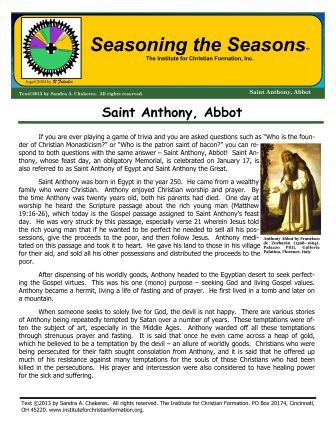The Institute for Christian Formation
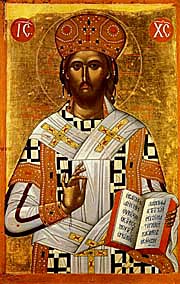
Saint Anthony, Abbot
Feast Day (Memorial): January 17
If you are ever playing a game of trivia and you are asked questions such as “Who is the founder of Christian Monasticism?” or “Who is the patron saint of bacon?” you can respond to both questions with the same answer – Saint Anthony, Abbot! Saint Anthony, whose feast day, an obligatory Memorial, is celebrated on January 17, is also referred to as Saint Anthony of Egypt and Saint Anthony the Great.
Saint Anthony was born in Egypt in the year 250. He came from a wealthy family who were Christian. Anthony enjoyed Christian worship and prayer. By the time Anthony was twenty years old, both his parents had died. One day at worship he heard the Scripture passage about the rich young man (Matthew 19:16-26), which
Saint Anthony (detail);
artist: Piero di Cosimo; 1480-1490; National Art Gallery – Washington D.C.
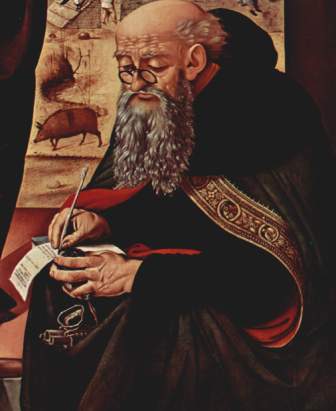
today is the Gospel passage assigned to Saint Anthony’s feast day. He was very struck by this passage, especially verse 21 wherein Jesus told the rich young man that if he wanted to be perfect he needed to sell all his possessions, give the proceeds to the poor, and then follow Jesus. Anthony meditated on this passage and took it to heart. He gave his land to those in his village for their aid, and sold all his other possessions and distributed the proceeds to the poor.
After dispensing of his worldly goods, Anthony headed to the Egyptian desert to seek perfecting the Gospel virtues. This was his one (mono) purpose – seeking God and living Gospel values. Anthony became a hermit, living a life of fasting and of prayer. He first lived in a tomb and later on a mountain.
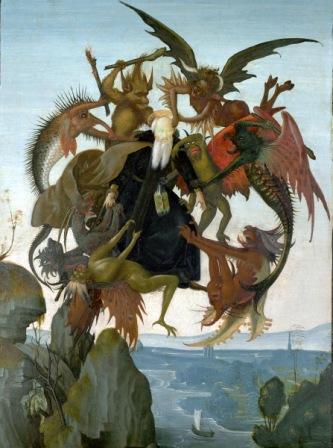
Michelangelo, The Torment of Saint Anthony, c. 1487-¬88. Oil and tempera on panel, 18 1/2 x 13 1/4 in. Kimbell Art Museum, Fort Worth. circa 1487-1488
When someone seeks to solely live for God, the devil is not happy. There are various stories of Anthony being repeatedly tempted by Satan over a number of years. These temptations were often the subject of art, especially in the Middle Ages. Anthony warded off all these temptations through strenuous prayer and fasting. It is said that once he even came across a heap of gold, which he believed to be a temptation by the devil – an allure of worldly goods. Christians who were being persecuted for their faith sought consolation from Anthony, and it is said that he offered up much of his resistance against many temptations for the souls of those Christians who had been killed in the persecutions. His prayer and intercession was also considered to have healing power for the sick and suffering.
Anthony’s asceticism and virtuous lifestyle attract-
ed many who came out to the desert to live like Anthony did. This way of life - living for one (mono) purpose/goal of seeking evangelical perfection and living for God alone – is called monasticism. Sometimes monks live alone as hermits and other times they live a community life in monasteries. Anthony is called the “Patriarch (or Father) of Monks” and is heralded as the early Founder of Christian Monasticism.
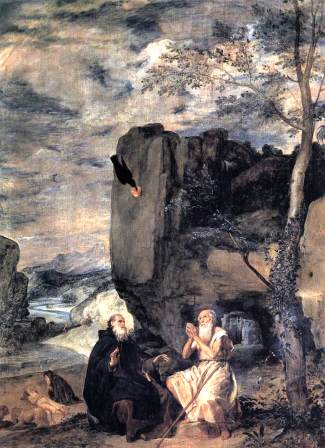
St. Anthony the Abbot and St. Paul the First Hermit by Diego Velazqueircaz, circa 1635. Museo del Prado, Madrid, Spain.
Another hermit of the time was St. Paul the Hermit. Once Anthony undertook a long and perilous journey to visit Paul and learn from him. Legend says that a raven brought one loaf of bread each for Paul and Anthony as their food. On a second journey to visit the hermit Paul, Anthony arrived to find that Paul had died. Now, as a hermit lives a life of solitude, no one else was nearby to discover or bury Paul’s body. As there was no shovel or other similar tool available, legend says that lions helped Anthony bury Paul’s body in the Egyptian desert. It is from this legend that Anthony is hailed as the patron saint of gravediggers.
A contemporary of Saint Anthony was Saint Athanasius of Alexandria. These two Egyptian holy men knew each other. Saint Anthony even assisted
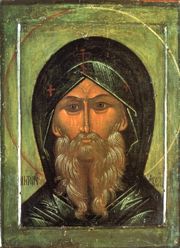
St. Anthony the Great (Novgorod, 16th century, Russian)
Saint Athanasius in his battle against the Arian heresy. (This was a heresy, or false teaching, which claimed Jesus Christ was not equal to God.)
Saint Anthony lived a very long life, dying in 356 at the age of 105 years. Shortly after his death, Saint Athanasius wrote a biography of Anthony, “The Life of Saint Antony.” You can still read this today. Here is a link to an English translation. This biography of Anthony was very influential in the spread of monasticism and monasteries throughout the Christian world.
In the 11th century, the relics of Saint Anthony were moved to Saint-Antoine de Viennois in France. In the Middle Ages there was a terrible skin disease which was referred to as “Saint Anthony’s Fire.” Saint Anthony was often invoked in prayer for healing from this painful disease, and there are many stories of the resulting miraculous cures. “Saint Anthony’s Fire” was the inspiration for a very famous artwork, Matthias Grünewald's 16th-century Isenheim Altarpiece, which glorified suffering and offered comfort to those afflicted with “Saint Anthony’s Fire.” You can learn more about this altarpiece here, and by watching the video below.
Saint Anthony is the patron of the Order of Hospitallers of St. Anthony, a monastic order founded in the Middle Ages who treated diseases of the poor, including “Saint Anthony’s Fire.” The members of this order wore a black habit. It is said they raised pigs for their support, and that the pigs roamed freely throughout the land with bells around their necks. The pigs were later butchered for their meat. Pork fat was also sometimes used to treat diseases of the skin, such as “Saint Anthony’s Fire.” In art and iconography, Saint Anthony is often pictured wearing a black monastic habit, sometimes with a pig near him. Saint Anthony is the patron saint of swine herders and pork butchers (all butchers, really), livestock, animals, and yes – even bacon!
Whether it is due to the Hospitallers and their pigs, or stories and legends which arose about Saint Anthony living in the desert as a hermit with pigs and other animals, Saint Anthony is considered a great patron of animals, livestock, herders, etc. One legend even says that late at night on the eve of Anthony’s January 17th feast day the animals in stables begin to speak! In many countries of the world, Saint Anthony’s feast day is heralded with animal blessings, blessings of livestock owners and herdsmen, parades, processions, large bonfires called “Bonfires of Saint Anthony”, music and special foods. Some animal owners decorate their animals with flowers and ribbons and even hats for the blessing of animals on the feast of Saint Anthony, and many times the animals are part of a big parade prior to the blessing. In areas of Spain, horses are even ridden through large bonfires to celebrate this feast day!
In Italy, the Feast day of Saint Anthony, Abbot is celebrated with the traditional blessing of animals and livestock, as the video below documents. Last year, the Italian Association of Livestock Farmers held a traditional exhibition of farm animals in front of St. Peter's Square. Mass for the farmers and their families was celebrated at the Vatican, followed by a procession of horses. A blessing was given to those present. Many Roman citizens attended the celebration with their pets.
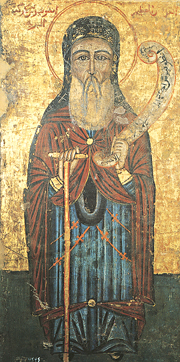
St. Anthony the Great (Coptic, 18th century). Museum of Coptic Art, Old Cairo.
Another attribute of Saint Anthony in art is the Tau cross, sometimes referred to as the Cross of Saint Anthony. Based on the Greek letter, Т, “tau” is also the last letter of the Hebrew alphabet and an ancient symbol for the center of the world. The staffs monks carry are often in the shape of the “tau.”
Celebrate Saint Anthony, Abbot’s January 17 feast day in style! Perhaps there is an animal blessing in your locale. If so, attend it. If not, if you are an animal owner, bless your own pets and/or livestock. Have an outdoor bonfire, or light a fire in your fireplace. Have bacon for breakfast and/or a nice roast pork dinner! (Here is a recipe for a Tuscan pork stew. Interestingly, Saint Anthony lived his entire life in Egypt, and today most Egyptians do not eat pork as Muslims do not eat pork.) Visit the sick. Pray for those who are ill or suffering. Go to Mass. Reflect on Matthew 19:16-26 as part of your prayer this day. Read Saint Athanasius’s “The Life of Saint Antony.” The “Golden Legend,” written in the 13th century by Jacobus de Voragine, also relates much about the saints, including
Saint Anthony and the cult that grew up around him. You can read this account of Saint Anthony here. But most of all, ask Saint Anthony to intercede that we, like him, might strive to follow Jesus single heartedly, heeding Jesus’ advice to the rich young man in the Gospel passage by which Anthony lived his life.
Click on the image above to download our handout on Saint Anthony, Abbot.
Saint Anthony is called the “Patriarch (or Father) of Monks” and is heralded as the early Founder of Christian Monasticism. Learn more about monasticism. An excellent book “The Historical Atlas of Eastern and Western Christian Monasticism,” by Juan María Laboa, Principal Author; and Matthew J. O'Connell, Translator, is available from Liturgical Press.
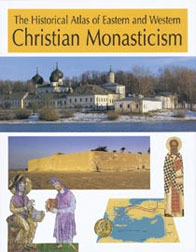
Celebrate Saint Anthony's Feast Day with Children/Students
1) Bake animal shaped cookies and let children decorate the cookies with flowers, bells, decorative hats, etc.
2) Plan a blessing of neighborhood animals/pets.
3) Have children make Saint Anthony Feast Day Cards. Draw pictures of Saint Anthony with a Tau cross and a pig on the front, and inside write well wishes and prayers for those who are sick and/or shut in. You could even deliver the cards to a local nursing home, and don’t forget to bring along some of your animal cookies.
4) Invite students to learn more about monks and monasticism.
5) Create an icon of Saint Anthony, Abbot, which includes an image of the saint surrounded by symbols and scenes from his life.
Follow us on Facebook to keep up to date with our news and newest resources!
